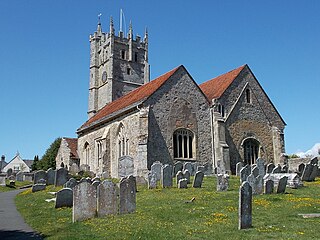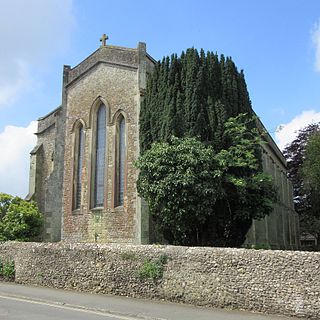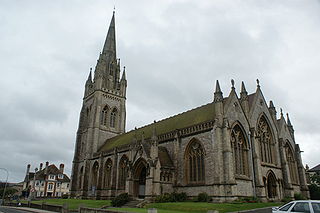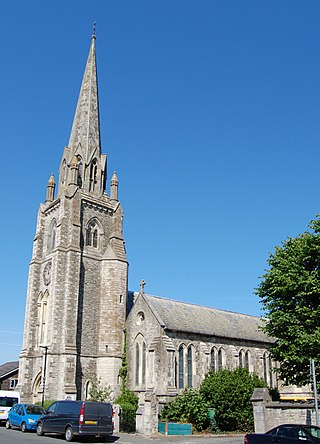
Ryde is an English seaside town and civil parish on the north-east coast of the Isle of Wight. The built-up area had a population of 24,096 according to the 2021 Census. Its growth as a seaside resort came after the villages of Upper Ryde and Lower Ryde were merged in the 19th century, as can still be seen in the town's central and seafront architecture. The resort's expansive sands are revealed at low tide. Their width means the regular ferry service to the mainland requires a long listed pier – the fourth longest in the United Kingdom, and the oldest surviving.

King's Chapel is an American independent Christian unitarian congregation affiliated with the Unitarian Universalist Association that is "unitarian Christian in theology, Anglican in worship, and congregational in governance." It is housed in what was for a time after the Revolution called the "Stone Chapel", an 18th-century structure at the corner of Tremont Street and School Street in Boston, Massachusetts. The chapel building, completed in 1754, is one of the finest designs of the noted colonial architect Peter Harrison, and was designated a National Historic Landmark in 1960 for its architectural significance. The congregation has worshipped according to a Unitarian version of the Book of Common Prayer since 1785, currently in its ninth edition.

Westminster Chapel is an evangelical free church in Westminster, central London. The church is in Buckingham Gate, on the corner of Castle Lane and opposite the junction with Petty France. Buckingham Gate is just off Victoria Street and near Buckingham Palace.

St. Peter's Cathedral, Charlottetown, Prince Edward Island, Canada, was founded in 1869 as a result of the influence of the Oxford Movement. Since that time, the parish has remained Anglo-Catholic in ethos and practice.

Holy Trinity Church (HTL Church) is an Anglican parish church in Leicester, England.

St Peter, Vere Street, known until 1832 as the Oxford Chapel after its founder Edward Harley, 2nd Earl of Oxford and Earl Mortimer, is a former Anglican church off Oxford Street, London. It has sometimes been referred to as the Marybone Chapel or Marylebone Chapel.

A proprietary chapel is a chapel that originally belonged to a private person, but with the intention that it would be open to the public, rather than restricted to members of a family or household, or members of an institution. Generally, however, some of the seating—sometimes a substantial proportion—would be reserved for subscribers.

St George's Church, Edgbaston, is a parish church in the Church of England in Edgbaston, Birmingham.

St Boniface Church, Bonchurch is a parish church in the Church of England located in Bonchurch, Isle of Wight.

St Mary's Church, Carisbrooke is a parish church in the Church of England located in Carisbrooke, Isle of Wight. A service is held every Sunday morning at 8:00 and 9:30.

The Church of St. John the Baptist, Newport is a parish church in the Church of England located in Newport, Isle of Wight. It is a Grade II listed building, the only surviving building by the British architect Robert Gunter Wetten (1804–1868).

All Saints' Church, Ryde is a parish church in the Church of England located in Ryde, Isle of Wight. The building is a landmark of the island, the spire being visible from many places around the Isle of Wight and from the mainland, projecting beyond the skyline. All Saints' is sometimes referred to as the "Cathedral of the Island" It is a Grade II* ecclesiastical listed building.

Holy Trinity Church is a former Church of England parish church located in the town of Ryde on the Isle of Wight. Opened in 1845, consecrated the following year and parished in 1863, it became the rapidly growing town's first parish church. A "fine, gracious" and "imposing" structure with a 134-foot (41 m) spire, it is visible for miles as a landmark at the northern end of the island, along with nearby All Saints' Church. The building has been used as a community centre since it closed for worship in 2014. Historic England has listed it at Grade II for its architectural and historical importance.

St. John's Church, Oakfield, Ryde is a parish church in the Church of England located in Ryde, Isle of Wight.

Grosvenor Chapel is an Anglican church in what is now the City of Westminster, in England, built in the 1730s. It inspired many churches in New England. It is situated on South Audley Street in Mayfair.

St James with Holy Trinity Church is in Seamer Road, Scarborough, North Yorkshire, England. It is an active Anglican parish church in the deanery of Scarborough, the archdeaconry of East Riding, and the diocese of York. The church is recorded in the National Heritage List for England as a designated Grade II listed building.
Dr. Richard Yates Mander FRCO LRAM was an English organist and composer.

Thomas Hellyer was an English architect of the mid-Victorian era. He was based on the Isle of Wight and was "the leading Island-based architect of the period". His works can also be found on the mainland—principally in Hampshire, but also further afield. Described by Pevsner as a "very individualistic" and "remarkable" architect, his output included churches, houses, schools and hospitals across the island, built during a period of rapid urban development. Many of his buildings have listed status and he "made important contributions to the appearance of the city" of Portsmouth through his extensive work in the area.

Holy Trinity is a Church of England church in the Anglo-Catholic tradition in Gosport, Hampshire, within the Anglican Diocese of Portsmouth.



















